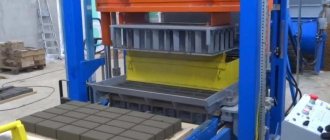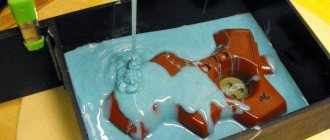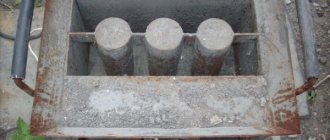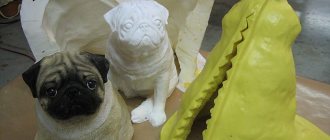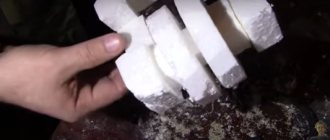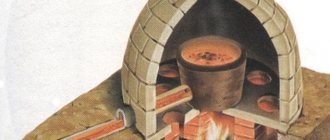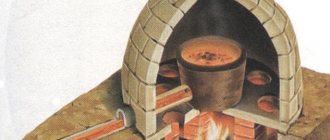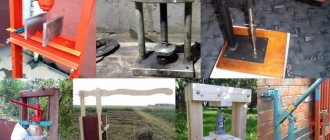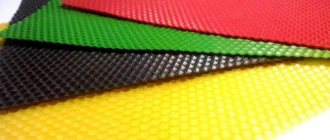Stamping is one of the most profitable methods of processing steel by pressure. It requires a press, a washer and a matrix, a mold, and scissors. Depending on the operation (bending, cutting, drawing, etc.), different molds are needed. The metal is stamped, both hot and cold.
Making a mold is a long and expensive process that requires a high level of preparation. You cannot do without a mold when producing multi-production parts: expensive equipment lasts a long time and leads to a reduction in the cost of the final product.
Material selection
High-strength steels that can withstand impact loads are used for molds. These steels are highly hardenable and have high toughness. The most commonly used are 40Х13 and 5ХНМ. For dies, durable steels St45, St40X, U8 are chosen.
For cold stamping, a hydraulic press is used due to the variety of its configurations and low metal consumption. For cutting and punching, choose a tool with a large washer stroke.
IMPORTANT! U8A and 8HF steels are not used for the manufacture of mold parts. U10A steel is hard after heat treatment, but parts manufactured with it will have to be subjected to additional machining.
Equipment and production stages
Instrumental support is included in a business project, since the efficiency of production activities depends on its completeness and quality. The first step is to buy heavy machines for making molds. Next is the computer equipment with which the forms are designed. Purchases are made from authorized dealers to eliminate maintenance problems and save on repairs if necessary.
Machines and costs for them in rubles:
- hydropneumatic press (126 thousand);
- milling machines (70 thousand);
- CNC machines (370 thousand);
- computers, software (108 thousand);
- injection molding equipment (81 thousand);
- hand tools, maintenance kits (14 thousand).
The cost of equipment for future profitable production at this stage will be slightly less than 770 thousand rubles, excluding delivery.
Mold production
The production of molds using modern technologies includes a number of successive stages:
- Development and approval of technical specifications for the mold. The type of gating system, the number of cavities, the working life of the mold, and the cycle of the casting process are determined.
- Development, design of forms. 3D modeling is used, which allows us to foresee and eliminate possible problems (calculate shrinkage and warping, etc.).
- Making a mold. A responsible process that includes a number of activities. First - the purchase of metal, tools for CNC machines, a set of cutters. Next is the production of mold parts and their subsequent assembly with adjustment to the mating pair.
- Testing. Molding tests are carried out using the materials specified in the technical specifications. Engineers and designers evaluate the performance of the mold and the quality of the products cast with its help.
- Acceptance and delivery works.
Each finished form is a piece product, the cost of which quickly pays off during operation. Production time varies in each individual case.
Manufacturing methods
There are three ways to make a stamping mold:
- Remaking an existing mold;
- Manufacturing from scratch;
- Assembly from ready-made materials.
The first option is extremely rare due to the costs; it’s easier to do it yourself. In the CIS countries they create forms from columns to form-building ones. There is a trend towards specialization of molds. All parts of the mold are made in different factories, and finally they are assembled into the finished product.
The production of molds for stamping aluminum parts is reduced in cost by reusing, without repairs, molds that have already served their purpose on more high-precision parts. Aluminum parts do not have tight tolerances, so this option is acceptable.
Product range
The business idea is suitable for investors with a significant amount of capital. To meet the needs of plastic and aluminum manufacturers, a wide range of molds is required. These are molds for the manufacture of household and household products, PET containers, electronics, sewer and water fittings, etc. If you have the appropriate equipment, you can meet the demand for the following types of molds:
- Single and multi-seat. Used for casting one or several parts per cycle;
- Family. The matrix and punch represent inserts, due to which you can diversify the scope of application of one form;
- Cold duct. Cheaper to manufacture, but finished products are more expensive;
- Hot runners. More difficult to manufacture, but saves raw materials for manufacturers of plastic products;
- With embedded elements;
- With hydraulic movable signs;
- With air pushers;
- Two-component, etc.
You can start a business by manufacturing the most popular molds in the region, gradually expanding the range taking into account the requests of regular and new customers.
Making molds from scratch
To create a mold, you need 2 sheets or bars of steel, depending on the shape of the product. One part will be responsible for the moving part of the structure (punch), and the second for the matrix.
Having selected materials for the workpieces and tools, you can create a form for stamping. Having the drawings of the part, the equipment is designed. Using a laser or lathe, holes and recesses are cut into the blanks for the mold. For reliability, you need to tightly fasten the two plates and fix them until the work is completed. Carefully debug the gating system. To make some parts of complex terrain, a milling machine and subsequent manual work with a file may be required.
The finished product is checked in operation on test products. This makes it possible to find out the result and adjust the mold in case of any inaccuracies. The gating system must be adjusted for best results.
Making a mold is a complex process, but necessary for mass production of parts.
How to make a mold
Mini-TPA does not require a full-fledged mold for casting plastic parts.
It is enough to make a form-building part that is part of any mold.
The form may consist of one, two, three, and so on parts. The main thing is that they must be tightly connected and kept assembled at the moment of plastic injection. Then, after injection, the mold should be easily disassembled into its components, and the part itself should be easily removed after casting.
Making a mold will be shown using the example of the task of casting a cord clip . This example is for a machine with an automatic clamping unit; modifications for a manual machine are also described below.
1. Draw the product.
2. Since the part is small, several such parts can be cast at a time. It was decided to cast 2 pieces at a time, since a small number of products are required.
A computer model of half the mold containing 2 parts is drawn. The injection is planned in the middle between the products. Since the requirements for the product are not high, it is customary to make the casting channels wide for easier casting.
There are threaded holes in the corners.
You can download a zip archive with files of this plate in stp and iges format from this link.
3. The front plate (the second half of the mold) is a smooth surface with a hole in the middle for the MiniTPA nozzle and also four threaded holes for fastening.
4. For ourselves, we have developed a set of frames for attaching various-sized forms with many through holes and with large holes in the corners for mounting on guides.
Subsequently, we abandoned the frames in their original form, leaving only vertical parts with bronze bushings.
Forms are attached to the holes; the hole dimensions for our case are indicated on the “Drawings” page. You have the right to choose them and arrange them as your detail requires.
5. We assemble the entire structure on the machine and make a test casting. All is ready.
6. In our case, we modified the mold, equipping it with pushers for automatic operation.
An example of work is shown in the video below:
Youtube link https://youtu.be/U-Puu40pGjw
Manual casting mold on the desktop
A mold for manual casting will have a minimum of differences: there is no need to make a hole in a flat plate - injection will occur along the line of closure of two plates (half-molds).
The form will need to be pinned to your desktop. The top lever will keep the mold from opening, the second will move the entire work table towards the injection nozzle.
We hope this information will be useful to you when designing and making your mold.
- one more example -
Making double dowels for installing heated floors
According to the above algorithm, a casting mold was designed and tested
double dowel for installing heated floors.
Form
The mold was made of aluminum for two reasons. The first is to test one hypothesis (technical solution), the second is to minimize risks in case of failure and at the same time save money in case of success. Everything worked out.
It was decided to make the mold in two places to fit within the 120 mm dimensions. The mold was designed for automatic casting and is equipped with pushers. Channels were made for cooling, since the thickness of one plate (half-mold) was more than 20 mm.
Below are photos of a mold consisting of two halves, photos of pushers and a plate for attaching pushers.
The parts are not cast in half in half-molds; in the half-mold with pushers, the part is immersed a little deeper, about 2 mm, to the depth of the side hooks. This is done so that after casting the parts remain in it.
It made sense. At the very beginning, when the injection dose was still being selected, with a small dose the part remained on the half-mold, which is closer to the spout. With the right dose, it stayed where the pushers were.
Taking measurements
A photo of the original from which the dimensions were taken is shown below. Dowel for pipe 25 mm white.
Dowel castings
The customer brought with him several polymers for testing. The weight of the casting was 21 grams, that is, a little more than 10 grams is the weight of one double dowel.
The first material is our standard polypropylene (orange dowel). It flows normally, no surprises or peculiarities. The shrinkage is almost invisible. We didn’t measure or remember the parameters because the material was expensive. They simply expelled the material and at the same time spilled it in test mode. Plus we warmed up the uniform.
A small dent at the top of the dowel is an unused injection dose, not a defect or shrinkage.
The second material is low-density polyethylene (gray-blue color). The processing temperature at the maximum point is 240 degrees Celsius. It pours well, but due to the high temperature, the cycle, even with cooling, was almost 100 seconds, this was categorically not satisfactory for the customer. In terms of tactile sensations, it is a very pleasant detail, rather heavy, and fits well in the hand.
A defect appeared due to poor cooling at the edges of the mold - shrinkage above the radius. This can easily be eliminated by drilling additional cooling channels in the required parts.
The third material is secondary (I don’t remember the name), under the code number “109” from the supplier (I find out the name and correct the test [O.N. Parfenov]), the color is also unclear. Low processing temperature, pours wonderfully, immediately reached a cycle of 57 seconds. The maximum melt temperature was in the range of 180-190 degrees Celsius.
The customer wished to further reduce the cycle. We made recommendations: add external air cooling, make additional channels for water cooling, reduce the stroke of the movable half-mold. The cycle time for such a casting of 40 seconds seems absolutely realistic.
Since this set of activities is not included in the regulations for testing Foma, the customer will do this independently at his own production site.
But the main advantage of this material is the price of 60 rubles per kilogram, that is, the price of casting 21 grams is 1 ruble 26 kopecks, or the price of material for casting one double dowel is 63 kopecks . In the store, such a dowel costs 5 rubles.
The appearance of the dowel did not bother the customer at all; it is smooth to the touch, although it seems that the entire surface is dotted with ditches, scratches, and dents. The material in the granules looked exactly the same as the product itself.
The fourth material required an increase in temperature, which entailed an increase in the cycle, so testing of the fourth material was stopped before it had really begun.
Form in action
Photo of the form in use. Cooling pipes are visible. The pushers begin to push the casting out.
Financial part
The direct costs for obtaining the result in the form of a suitable casting of a double dowel for a heated floor were (all prices according to the price list):
- Removing sizes - 5000 rubles.
- Design - 35,000 rub.
- Manufacturing - 30,000 rubles.
- Testing - 15,000 rubles. The price for testing is indicated taking into account the subsequent discount when purchasing equipment.
- Material testing 4 pcs. - for free.
Total: 85,000 rubles.
We continue our cooperation - we started designing a mold (first taking dimensions) for the next product on the list: brackets for attaching a pipe to polystyrene foam.
Photo of the original part is below.
Latest news from the client
We managed to reduce the cycle to 24 (!!!) seconds.
Our congratulations!
